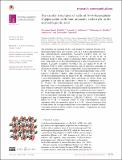Files in this item
The crystal structures of salts of N-(4-fluorophenyl)piperazine with four aromatic carboxylic acids and with picric acid
Item metadata
| dc.contributor.author | Harish Chinthal, Chayanna | |
| dc.contributor.author | Yathirajan, Hemmige S | |
| dc.contributor.author | Kavitha, Channappa N | |
| dc.contributor.author | Foro, Sabine | |
| dc.contributor.author | Glidewell, Christopher | |
| dc.date.accessioned | 2020-11-19T10:30:11Z | |
| dc.date.available | 2020-11-19T10:30:11Z | |
| dc.date.issued | 2020-08 | |
| dc.identifier | 271286464 | |
| dc.identifier | 866eff37-29c1-4cbe-86b4-67518ef92a5e | |
| dc.identifier | 32843996 | |
| dc.identifier | 85090374664 | |
| dc.identifier | 000569355400002 | |
| dc.identifier.citation | Harish Chinthal , C , Yathirajan , H S , Kavitha , C N , Foro , S & Glidewell , C 2020 , ' The crystal structures of salts of N -(4-fluorophenyl)piperazine with four aromatic carboxylic acids and with picric acid ' , Acta Crystallographica Section E Crystallographic Communications , vol. 76 , no. Part 8 , pp. 1179-1186 . https://doi.org/10.1107/S2056989020008749 | en |
| dc.identifier.issn | 2056-9890 | |
| dc.identifier.other | Jisc: 9d616454807b4661b05c0573b5041e40 | |
| dc.identifier.other | pii: hb7928 | |
| dc.identifier.other | pmc: PMC7405574 | |
| dc.identifier.uri | https://hdl.handle.net/10023/21011 | |
| dc.description | HSY thanks the University Grants Commission, New Delhi, for the award of a BSR Faculty Fellowship for three years. | en |
| dc.description.abstract | The structures are reported for five salts formed by reactions between N-(4-fluorophenyl)piperazine and aromatic acids. In 4-(4-fluorophenyl)piperazin-1-ium 2-fluorobenzoate monohydrate, C10H14FN2+·C7H4FO2−·H2O, (I), the components are linked by a combination of N—H⋯O and O—H⋯O hydrogen bonds to form a chain of alternating R46(12) and R66(16) rings. The ionic components of 4-(4-fluorophenyl)piperazin-1-ium 2-bromobenzoate 0.353-hydrate, C10H14FN2+·C7H4BrO2−·0.353H2O, (II), are linked by N—H⋯O hydrogen bonds to form a centrosymmetric four-ion aggregate containing an R44(12) motif, and these aggregates are linked into a molecular ladder by a single C—H⋯π(arene) hydrogen bond. 4-(4-Fluorophenyl)piperazin-1-ium 2-iodobenzoate, C10H14FN2+·C7H4IO2−, (III), crystallizes with Z′ = 2 in space group P: the four independent ions are linked by N—H⋯O hydrogen bonds to form a non-centrosymmetric aggregate again containing an R44(12) motif, and aggregates of this type are linked into a ribbon by a combination of C—H⋯O and C—H⋯π(arene) hydrogen bonds. The anion in 4-(4-fluorophenyl)piperazin-1-ium 2,4,6-trinitrophenolate, C10H14FN2+·C6H2N3O7−, (IV), shows clear evidence of extensive electronic delocalization from the phenolate O atom into the adjacent ring. The ions are linked by a combination of two-centre N—H⋯O and three-centre N—H⋯(O)2 hydrogen bonds to form centrosymmetric four-ion aggregates containing three types of ring. The ions in 4-(4-fluorophenyl)piperazin-1-ium 3,5-dinitrobenzoate, C10H14FN2+·C7H3N2O6−, (V), are again linked by N—H⋯O hydrogen bonds to form centrosymmetric R44(12) aggregates, which are themselves linked by a C—H⋯π(arene) hydrogen bond to form sheets, the stacking of which leads to the formation of narrow channels, containing disordered and/or mobile solvent entities. Comparisons are made with some related structures. | |
| dc.format.extent | 34 | |
| dc.format.extent | 2132582 | |
| dc.language.iso | eng | |
| dc.relation.ispartof | Acta Crystallographica Section E Crystallographic Communications | en |
| dc.subject | Crystal structure | en |
| dc.subject | Hydrogen bonding | en |
| dc.subject | Molecular structure | en |
| dc.subject | Piperazine salts | en |
| dc.subject | Piperazines | en |
| dc.subject | Supramolecular assembly | en |
| dc.subject | QD Chemistry | en |
| dc.subject | DAS | en |
| dc.subject.lcc | QD | en |
| dc.title | The crystal structures of salts of N-(4-fluorophenyl)piperazine with four aromatic carboxylic acids and with picric acid | en |
| dc.type | Journal article | en |
| dc.contributor.institution | University of St Andrews. School of Chemistry | en |
| dc.identifier.doi | 10.1107/S2056989020008749 | |
| dc.description.status | Peer reviewed | en |
This item appears in the following Collection(s)
Items in the St Andrews Research Repository are protected by copyright, with all rights reserved, unless otherwise indicated.

